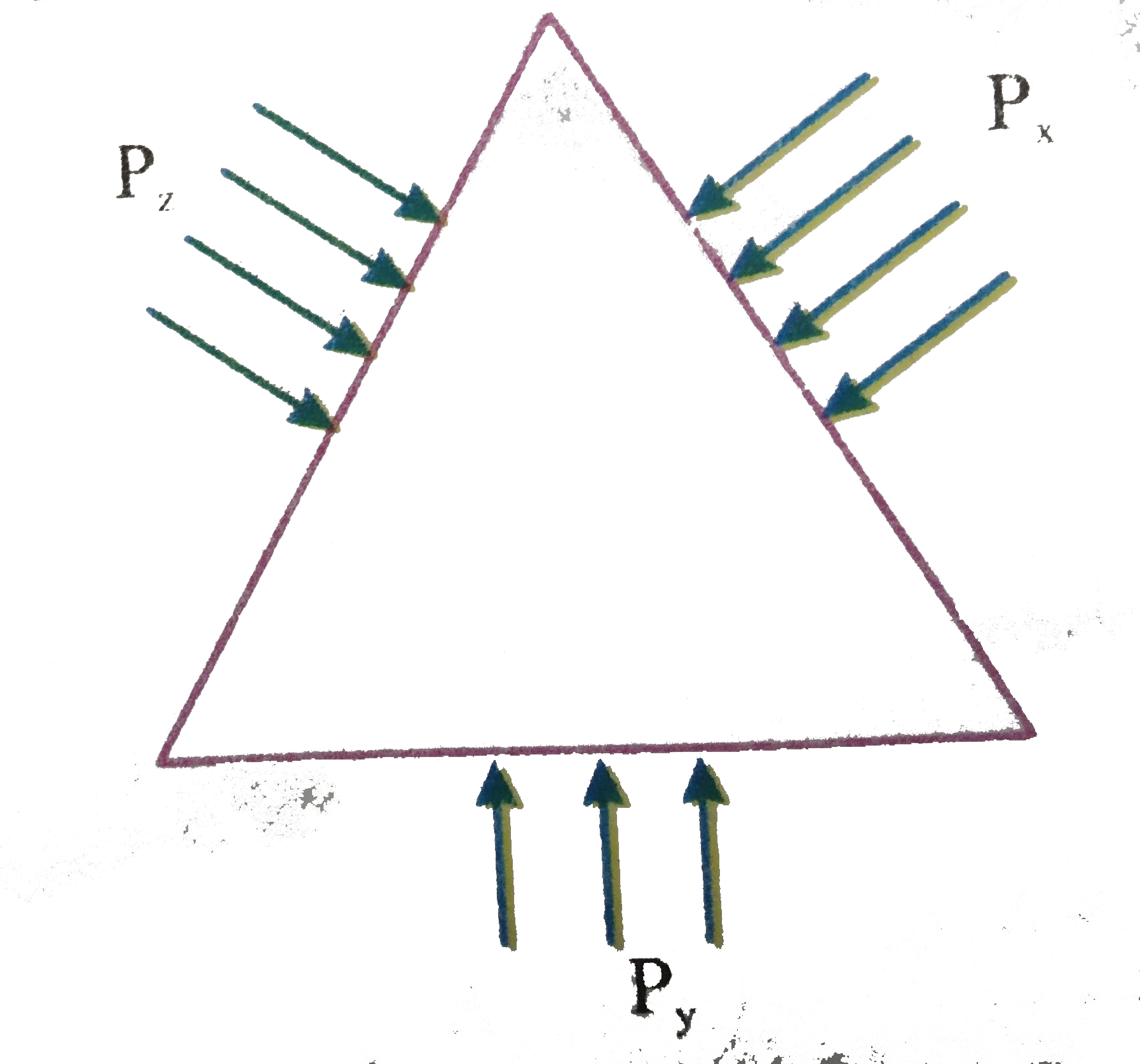Consider a vessel filled with a liquid upto height H. The bottom of the vessel lies in the XY-plane passing through the origin. The density of the liquid varies with Z-axis as ρ(z)=ρ0[2−(zH)2]. If p1 and p2 are the pressures at the bottom surface and top surface of the liquid, the magnitude of (p1−p2) isSolution in Telugu
ρ0gH
85ρ0gH
32ρ0gH
53ρ0gH
The correct Answer is:D
Given that P(Z)=ρ0(2−(ZH)2)
Let a small column of liquid thickness be dz.
Pressure due to column,
dP1=ρ0((2−ZH)2)gdz+P2
P1=∫π0ρ0(2−(ZH)2)gdz+P2

ρ0g∫(0)π(2−Z2H2)dz+P2
=ρ0g(2H−13H2(H3))+P2
P1=ρ0g(2H−H3)+P2
P1−P2=ρ0g(5H)3=53ρ0gH
Topper's Solved these Questions
- EAMCET - 2018 (TS) SHIFT - 1BOOK - SIA PUBLICATIONCHAPTER - EAMCET - 2018 (TS) SHIFT - 1EXERCISE - EXERCISE - Chemistry
8 Videos
- EAMCET - 2018 (TS) SHIFT - 1BOOK - SIA PUBLICATIONCHAPTER - EAMCET - 2018 (TS) SHIFT - 1EXERCISE - EXERCISE - Chemistry
8 Videos
- DIFFERENTIATION BOOK - SIA PUBLICATIONCHAPTER - DIFFERENTIATION EXERCISE - Problems
50 Videos
- EAMCET - 2018 (TS) SHIFT - 2BOOK - SIA PUBLICATIONCHAPTER - EAMCET - 2018 (TS) SHIFT - 2EXERCISE - Chemistry
18 Videos
Similar Questions
Match the reactants in List - I with the products in List - II
List - I List - II(a)H2O+H2S(i)(H3O+,HS−)(b)H2O+N3−(ii)(NH3,OH−)(c)H2O+SiCI4(iii)(OH−,H3S+)(d)H2O+F2(iv)(SiO2,HCI)(v)(SiO4−4,HCI)(vi)(O2,F−)(vii)(HF,OH−)(viii)(OH−,HN3)
The correct answer is
View SolutionMatch the reactants in List - I with the products in List - II
List - I List - II(a)H2O+H2S(i)(H3O+,HS−)(b)H2O+N3−(ii)(NH3,OH−)(c)H2O+SiCI4(iii)(OH−,H3S+)(d)H2O+F2(iv)(SiO2,HCI)(v)(SiO4−4,HCI)(vi)(O2,F−)(vii)(HF,OH−)(viii)(OH−,HN3)
The correct answer is
View SolutionIf x=1−√y1+√9, then (x+1)d2ydx2+(3√y+1√y)dydx=
View SolutionStatement (a) : Na2O<MgO<ZnO<P4O16−Acidic property
Statement (b) : F>CI>Br− Electron gain enthalpy
Statement (c ) : M2−>M−>M+>M2+- ionic size
Statement (d) : The second ionisation enthalpy of Cu is more than second ionisation enthalpy of K.
Which of the following is the correct representation of True (T) / Fale(F) for the given statements
View SolutionCalculate the pressure inside a small air bubble of radus r situated at a depth h below the free surface of liquids of densities ρ1 and ρ2 and surface tennsions T1 and T2. The thickness of the first and second liquids are h1 and h2 respectively. Take atmosphere pressure =P0.

View Solution
A triangular element of the liquid is shown in the fig. Px,Py and Pz represent the pressures on the element of the liquid then:
View SolutionA metal sphere connected by a string is dipped in a liquid of density rho as shown in figure. The pressure at the bottom of the vessel will be, (p_(0) =atmospheric pressure )
View SolutionThe top surface of an incompressible liquid is open to the atmosphere. The pressure at a depth h1 below the surface is p1 . What is the pressure p2 at depth h2=2h1 compare with p1 ?
View SolutionLet P1:2x+y+z+1=0
P2:2x−y+z+3=0 and P3:2x+3y+z+5=0 be three planes, then the distance of the line of intersection of planes P1=0 and P2=0 from the plane P3=0 is
View SolutionConsider a vessel filled with a liquid upto height H. The bottom of the vessel lies in the XY-plane passing through the origin. The density of the liquid varies with Z-axis as ρ(z)=ρ0[2−(zH)2]. If p1 and p2 are the pressures at the bottom surface and top surface of the liquid, the magnitude of (p1−p2) is
View SolutionA metal sphere connected by a string is dipped in a liquid of density rho as shown in figure. The pressure at the bottom of the vessel will be, (p_(0) =atmospheric pressure )
View SolutionCalculate the pressure inside a small air bubble of radus r situated at a depth h below the free surface of liquids of densities ρ1 and ρ2 and surface tennsions T1 and T2. The thickness of the first and second liquids are h1 and h2 respectively. Take atmosphere pressure =P0.

View SolutionThe pressure P1 at the top of a dam and P2 at a depth h from the top inside water (density ρ) are related as :
View SolutionLet P1:2x+y+z+1=0
P2:2x−y+z+3=0 and P3:2x+3y+z+5=0 be three planes, then the distance of the line of intersection of planes P1=0 and P2=0 from the plane P3=0 is
View SolutionA cylindrical vessel is filled with a liquid of density ρ to a height h such that the force exerted by the liquid on the bottom is equal to the force exerted on the walls of the vessel. Then h should be
View Solution
